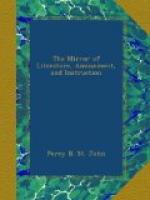FISHMONGER’S HALL
[Illustration: Fishmongers’ hall.]
[Illustration: Arms of the company.]
These Cuts may be welcome illustrations of the olden magnificence of the City of London. The first represents the river or back front of the Hall of the Fishmongers’ Company: the second cut, the arms of the Company, is added by way of an illustrative pendent. These insignia are placed over the entrance to the Hall in Lower Thames-street; they are sculptured in bold relief, and are not meanly executed. The Hall, or the greater part of it, has been taken down to make room for the New London Bridge approaches; the frame-work of the door, and the arms still remain—stat portus umbra.
The Hall merits further notice; not so much for its architectural pretensions as for its being the commencement of a plan which it could be wished had been completed. The reader may probably remember that after the Great Fire of London, the King (Charles II.) desired Wren, in addition to his designs for St. Paul’s, to make an accurate survey and drawing of the whole area and confines of the waste metropolis; and “day, succeeding day, amidst ashes and ruins, did this indefatigable man labour to fulfil his task.” He prepared his plans for rebuilding the city, and laid them before the King. That part of Sir Christopher’s plan which relates to the present subjects, was as follows: “By the water-side, from the bridge to the Temple, he had planned a long and broad wharf or quay, where he designed to have arranged all the halls that belong to the several companies of the city, with proper warehouses for merchants between, to vary the edifices, and make it at once one of the most beautiful ranges of structure in the world."[1] King Charles, however, as Mr. Cunningham observes, “was never obstinate in any thing for his country’s good,” and the idea was dropped: but Wren erected the above Hall as a specimen of his intention of ornamenting the banks of the Thames. The original hall was destroyed by the Great Fire.
The ancient importance of the Fishmongers’ Company may be thus explained:—
During the days of papacy in England, fish was an article not of optional, but compulsive consumption, and this rendered the business of a fishmonger one of the principal trades of London. Fish Street Hill, and the immediate vicinity, was the great mart for this branch of traffic, from its close connexion with the river, and here lived many illustrious citizens, particularly Sir William Walworth, and Sir Stephen Fisher.
Strong prejudices were however entertained against the fishmongers, and to so great an extent was it carried, that in the fourteenth century, they prayed the king, by Nicholas Exton, one of their body, that he would take the company under his protection, “lest they might receive corporeal hurt.” The parliament itself appears to have imbibed the general distrust, for in 1382 they enacted, “that no fishmonger should be mayor of the city.” This was repealed, however, the following year.




